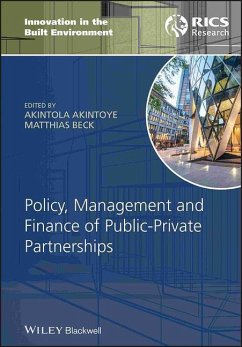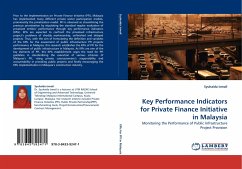Policy, Management and Finance of Public-Private Partnerships
Herausgeber: Akintoye, Akintola; Beck, Matthias
Policy, Management and Finance of Public-Private Partnerships
Herausgeber: Akintoye, Akintola; Beck, Matthias
- Gebundenes Buch
- Merkliste
- Auf die Merkliste
- Bewerten Bewerten
- Teilen
- Produkt teilen
- Produkterinnerung
- Produkterinnerung
Innovation in the Built Environment This book examines some of the key policy, financial and managerial aspects of public-private partnerships within the context of the global spread of this form of procurement. The chapters investigate political and institutional issues surrounding PPPs, together with the financial and managerial strategies employed by the private sector. Adopting a cross-disciplinary perspective, the book highlights the often politically sensitive nature of these projects and identifies a need for the private sector to investigate a broad set of parameters which relate to…mehr
Andere Kunden interessierten sich auch für
![Governance & Knowledge Management for Public-Private Partnerships Governance & Knowledge Management for Public-Private Partnerships]() Herbert RobinsonGovernance & Knowledge Management for Public-Private Partnerships114,99 €
Herbert RobinsonGovernance & Knowledge Management for Public-Private Partnerships114,99 €![Public Private Partnerships Public Private Partnerships]() Akintola Akintoye / Matthias Beck / Cliff Hardcastle (eds.)Public Private Partnerships159,99 €
Akintola Akintoye / Matthias Beck / Cliff Hardcastle (eds.)Public Private Partnerships159,99 €![Strategic Issues in Public-Private Partnerships Strategic Issues in Public-Private Partnerships]() Geert DewulfStrategic Issues in Public-Private Partnerships110,99 €
Geert DewulfStrategic Issues in Public-Private Partnerships110,99 €![Principles of Public and Private Infrastructure Delivery Principles of Public and Private Infrastructure Delivery]() John B. MillerPrinciples of Public and Private Infrastructure Delivery76,99 €
John B. MillerPrinciples of Public and Private Infrastructure Delivery76,99 €![Principles of Public and Private Infrastructure Delivery Principles of Public and Private Infrastructure Delivery]() John B. MillerPrinciples of Public and Private Infrastructure Delivery106,99 €
John B. MillerPrinciples of Public and Private Infrastructure Delivery106,99 €![Sustainable Private Finance Initiative Projects in the UK Sustainable Private Finance Initiative Projects in the UK]() Lei ZhouSustainable Private Finance Initiative Projects in the UK40,99 €
Lei ZhouSustainable Private Finance Initiative Projects in the UK40,99 €![Key Performance Indicators for Private Finance Initiative in Malaysia Key Performance Indicators for Private Finance Initiative in Malaysia]() Syuhaida IsmailKey Performance Indicators for Private Finance Initiative in Malaysia51,99 €
Syuhaida IsmailKey Performance Indicators for Private Finance Initiative in Malaysia51,99 €-
-
-
Innovation in the Built Environment This book examines some of the key policy, financial and managerial aspects of public-private partnerships within the context of the global spread of this form of procurement. The chapters investigate political and institutional issues surrounding PPPs, together with the financial and managerial strategies employed by the private sector. Adopting a cross-disciplinary perspective, the book highlights the often politically sensitive nature of these projects and identifies a need for the private sector to investigate a broad set of parameters which relate to the particular political economy of individual partnerships. Policy, Finance & Management for Public-Private Partnerships covers a range of specific issues, including: partnerships in developing countries; innovation in partnership-based procurement; government and business interaction; institutional and organisational approaches to facilitating partnership; project and corporate financing; risk and value management; market analysis, modelling and forecasting; capital structure decisions and management; investment theory and practice; pricing and cost evaluation; statutory regulations and their financial implications; option pricing; financial monitoring; syndicate funding; new roles for the financial and insurance sectors; institutional and multilateral funding; payment mechanisms; concession period determination; risk analysis and management; whole life value methodology; cost comparators and best value; team building, team work and skill development. Contributions from Australia, Europe, the Far East, South Africa and the United States together present the current thinking and state-of-the-art approaches to public-private partnerships.
Produktdetails
- Produktdetails
- Verlag: Wiley
- Seitenzahl: 512
- Erscheinungstermin: 10. November 2008
- Englisch
- Abmessung: 241mm x 180mm x 33mm
- Gewicht: 1225g
- ISBN-13: 9781405177917
- ISBN-10: 1405177918
- Artikelnr.: 25329084
- Herstellerkennzeichnung
- Libri GmbH
- Europaallee 1
- 36244 Bad Hersfeld
- gpsr@libri.de
- Verlag: Wiley
- Seitenzahl: 512
- Erscheinungstermin: 10. November 2008
- Englisch
- Abmessung: 241mm x 180mm x 33mm
- Gewicht: 1225g
- ISBN-13: 9781405177917
- ISBN-10: 1405177918
- Artikelnr.: 25329084
- Herstellerkennzeichnung
- Libri GmbH
- Europaallee 1
- 36244 Bad Hersfeld
- gpsr@libri.de
Akintola Akintoye, Professor of Construction Economics and Management and Head of School, School of Built and Natural Environment, University of Central Lancashire, Preston, UK Matthias Beck, Professor of Public Sector Management, The York Management School, University of York, UK
Foreword xi
Contributors xiii
Acknowledgements xxiii
Introduction xxv
Part One PPP Policy 1
Chapter 1 Private Finance Initiative in Use 3
Ezekiel Chinyio and Rod Gameson
1.1 Introduction 3
1.2 The Private Finance Initiative 4
1.3 UK Government's Influence on the Use of PFI 5
1.4 Private Sector Tasks in PFI 6
1.5 Establishing PFI Contracts 6
1.6 Forms of Finance Used in PFI 8
1.7 Performance of PFI Schemes - A Theoretical Perspective 10
1.8 Improving the Performance of PFI 14
1.9 Performance of PFI Schemes - An Empirical Review 14
1.10 A Generic Overview of PFI Schemes 19
1.11 Comparative Studies 20
1.12 Conclusion 20
Chapter 2 Using the Private Sector to Finance Capital Expenditure: The
Financial Realities 27
Jean Shaoul
2.1 Introduction 27
2.2 The Control of PFI 30
2.3 Post-implementation Evaluation of PFI 34
2.4 Conclusion 42
Chapter 3 Obstacles to Accountability in PFI Projects 47
Darinka Asenova and Matthias Beck
3.1 Introduction 47
3.2 Finance Capital and Institutional Decision Making 51
3.3 Conclusion 61
Chapter 4 Refinancingand Profitability of UK PFI Projects 64
Steven Toms, Darinka Asenova and Matthias Beck
4.1 Introduction 64
4.2 PFI Finance and Value for Money 65
4.3 Mechanisms and Policies of Refinancing 69
4.4 PFI Profits and Refinancing 72
4.5 Conclusion 77
Chapter 5 The Dedicated PPP Unit of the South African National Treasury 82
Philippe Burger
5.1 Introduction 82
5.2 The Rationale for PPPs 83
5.3 The Rationale for a Dedicated PPP Unit 84
5.4 A Brief History of PPPs and the PPP Unit in South Africa 86
5.5 The Role of the South African Dedicated PPP Unit 90
5.6 Future Challenges 93
5.7 Conclusion 95
Chapter 6 PPP in Greenfield Airport Development: A Case Study of Cochin
International Airport Limited 97
Thillai A. Rajan, Sheetal Sharad and Sidharth Sinha
6.1 Introduction 97
6.2 Private Participation in New Airport Development 99
6.3 Indian Aviation Sector 103
6.4 The Cochin International Airport Project 105
6.5 Performance of CIAL 112
6.6 Summary and Lessons 117
Chapter 7 PPPs for Physical Infrastructure in DevelopingCountries 123
Akintola Akintoye
7.1 Introduction 123
7.2 An Overview of Public-Private Partnerships 124
7.3 PPP: Developed Economies 125
7.4 PPP: Developing Economies 127
7.5 PPP: Analysis of Private Sector Participation 129
7.6 Discussion 138
7.7 Conclusions 141
Chapter 8 Team Buildingfor PPPs 145
Mohan M. Kumaraswamy, Florence Y.Y. Ling and Aaron M. Anvuur
8.1 Introduction 145
8.2 Integrating and Sustaining PPP Teams 147
BLBK049-Akintoye July 30, 2008 13:38 8.3 Hong Kong Perspectives of PPP
Teams 149
8.4 Singapore Perspectives of PPP Teams 153
8.5 Integrating PPP Project Teams 156
8.6 Selecting Project Consortium Teams 156
8.7 Concluding Observations 160
Part Two PPP Finance 163
Chapter 9 PPP Infrastructure Investments: Critical Aspects and Prospects
165
Demos C. Angelides and Yiannis Xenidis
9.1 Introduction 165
9.2 Critical Issues in Financing PPP Projects 167
9.3 Prospects for PPP Infrastructure Development 171
9.4 Conclusion 178
Chapter 10 Patterns of Financing PPP Projects 181
Sudong Ye
10.1 Introduction 181
10.2 General Patterns of Financing PPP Projects 186
10.3 Choice of Financing Patterns 195
10.4 Summary 196
Chapter 11 PPP Financingin the USA 198
Arthur L. Smith
11.1 Introduction 198
11.2 PPP Financing Models in the US 200
11.3 Case Studies 206
11.4 Conclusions 210
Chapter 12 Financial Modelling of PPP Projects 212
Ammar Kaka and Faisal Alsharif
12.1 Introduction 212
12.2 Research in PPP Financial Modelling 213
12.3 Cost Models 214
12.4 Occupancy Cost 215
12.5 Cash Flow Models 217
12.6 PFI Financial Modelling in Practice 217
12.7 An Example of a PFI Financial Model for Schools 224
12.8 Conclusion 226
Chapter 13 Application of Real Options in PPP Infrastructure Projects:
Opportunities and Challenges 229
Charles Y.J. Cheah and Michael J. Garvin
13.1 Introduction 229
13.2 Infrastructure Project Flexibility as Real Options 231
13.3 Real Options Literature Related to Architecture, Engineering,
Construction and Infrastructure Projects 234
13.4 Modelling Issues and Concerns 237
13.5 An Integrated Real Options-Risk Management Process for PPP
Infrastructure Projects 244
13.6 Summary 245
Chapter 14 Financial Implications of Power Purchase Agreement Clauses in
Revenue Stream of Independent Power Producers in Nepal 250
Raju B. Shrestha and Stephen Ogunlana
14.1 Introduction 250
14.2 Financial Analysis 252
14.3 Analyses of Clauses 255
14.4 Summary 263
Chapter 15 Government Policy on PPP Financial Issues: Bid Compensation and
Financial Renegotiation 267
S. Ping Ho
15.1 Introduction 267
15.2 Game Theory 268
15.3 Is Bid Compensation Effective in PPP Tendering? 271
15.4 Financial Renegotiation and its Associated Problems 280
15.5 Financial Renegotiation Game and its Equilibrium 281
15.6 Propositions and Rules 289
15.7 Governing Principles and Policy Implications for Project Procurement
and Management 292
15.8 Conclusion 299
Part Three PPP Management 301
Chapter 16 Innovation in PPP 303
David Eaton and R¿fat Akbiyikli
16.1 Introduction 303
16.2 Innovation and Competitive Advantage in PPP 304
16.3 Stimulants and Impediments to Innovation in PFI/PPP Projects 314
16.4 Innovation and Financial Issues in PFI/PPP Projects 319
16.5 Conclusion 324
Chapter 17 Combining Finance and Design Innovation to Develop Winning
Proposals 327
Colin F. Duffield and Chris J. Clifton
17.1 Introduction 327
17.2 The Drivers of PFI/PPP Projects in Different Jurisdictions 327
17.3 Design Innovation: The Issues 329
17.4 Financing Arrangements for PFI/PPP Projects 333
17.5 The Theory and Practice of Winning Proposals 342
Chapter 18 The Application of a Whole-Life Value Methodology to PPP/PFI
Projects 346
John Kelly
18.1 Introduction 346
18.2 Projects 346
18.3 Client Value System 349
18.4 Whole-Life Costing 351
18.5 The Application of Whole-Life Value to the PPP/PFI Process 356
18.6 Discussion 360
Chapter 19 Best Value Procurement in Build Operate Transfer Projects: The
Turkish Experience 363
Irem Dikmen, M. Talat Birgonul and Guzide Atasoy
19.1 Introduction 363
19.2 Bid Evaluation in BOT Projects 365
19.3 Case Studies 367
19.4 Best Value Procurement in BOT Projects 370
19.5 An Application of the Proposed Methodology 372
19.6 Concluding Remarks 376
Chapter 20 Application of Risk Analysis in Privately Financed Projects: The
Value For Money Assessment through the Public Sector Comparator and Private
Finance Alternative 379
Tony Merna and Douglas Lamb
20.1 Introduction 379
20.2 The PSC and the PFA 381
20.3 Conclusion 395
Chapter 21 Developing a Framework for Procurement Options Analysis 398
Darrin Grimsey and Mervyn K. Lewis
21.1 Introduction 398
21.2 What do PPPs Bring to Procurement? 398
21.3 Developing a Methodology 399
21.4 Conclusion 412
Chapter 22 The Payment Mechanism in Operational PFI Projects 414
Jon Scott and Herbert Robinson
22.1 Introduction 414
22.2 The Key Principles 414
22.3 Value for Money Arguments 415
22.4 Key Components of the Payment Mechanism 416
22.5 The Output Specification 419
22.6 Performance Measurement System 421
22.7 Case Studies 424
22.8 Analysis and Discussion of Findings 429
22.9 Concluding Remarks 433
Chapter 23 Concession Period Determination for PPP Infrastructure Projects
in HongKong 436
Xueqing Zhang
23.1 Introduction 436
23.2 PPP Projects in Hong Kong 437
23.3 Build, Operate, Transfer Scheme 440
23.4 Concession Period 441
23.5 Concession Period Determination Methods 443
23.6 Simulation-Based Concession Period Determination Methodology 444
23.7 Simulation-Based Concession Period Determination Framework 446
23.8 Conclusions 454
Index 457
Contributors xiii
Acknowledgements xxiii
Introduction xxv
Part One PPP Policy 1
Chapter 1 Private Finance Initiative in Use 3
Ezekiel Chinyio and Rod Gameson
1.1 Introduction 3
1.2 The Private Finance Initiative 4
1.3 UK Government's Influence on the Use of PFI 5
1.4 Private Sector Tasks in PFI 6
1.5 Establishing PFI Contracts 6
1.6 Forms of Finance Used in PFI 8
1.7 Performance of PFI Schemes - A Theoretical Perspective 10
1.8 Improving the Performance of PFI 14
1.9 Performance of PFI Schemes - An Empirical Review 14
1.10 A Generic Overview of PFI Schemes 19
1.11 Comparative Studies 20
1.12 Conclusion 20
Chapter 2 Using the Private Sector to Finance Capital Expenditure: The
Financial Realities 27
Jean Shaoul
2.1 Introduction 27
2.2 The Control of PFI 30
2.3 Post-implementation Evaluation of PFI 34
2.4 Conclusion 42
Chapter 3 Obstacles to Accountability in PFI Projects 47
Darinka Asenova and Matthias Beck
3.1 Introduction 47
3.2 Finance Capital and Institutional Decision Making 51
3.3 Conclusion 61
Chapter 4 Refinancingand Profitability of UK PFI Projects 64
Steven Toms, Darinka Asenova and Matthias Beck
4.1 Introduction 64
4.2 PFI Finance and Value for Money 65
4.3 Mechanisms and Policies of Refinancing 69
4.4 PFI Profits and Refinancing 72
4.5 Conclusion 77
Chapter 5 The Dedicated PPP Unit of the South African National Treasury 82
Philippe Burger
5.1 Introduction 82
5.2 The Rationale for PPPs 83
5.3 The Rationale for a Dedicated PPP Unit 84
5.4 A Brief History of PPPs and the PPP Unit in South Africa 86
5.5 The Role of the South African Dedicated PPP Unit 90
5.6 Future Challenges 93
5.7 Conclusion 95
Chapter 6 PPP in Greenfield Airport Development: A Case Study of Cochin
International Airport Limited 97
Thillai A. Rajan, Sheetal Sharad and Sidharth Sinha
6.1 Introduction 97
6.2 Private Participation in New Airport Development 99
6.3 Indian Aviation Sector 103
6.4 The Cochin International Airport Project 105
6.5 Performance of CIAL 112
6.6 Summary and Lessons 117
Chapter 7 PPPs for Physical Infrastructure in DevelopingCountries 123
Akintola Akintoye
7.1 Introduction 123
7.2 An Overview of Public-Private Partnerships 124
7.3 PPP: Developed Economies 125
7.4 PPP: Developing Economies 127
7.5 PPP: Analysis of Private Sector Participation 129
7.6 Discussion 138
7.7 Conclusions 141
Chapter 8 Team Buildingfor PPPs 145
Mohan M. Kumaraswamy, Florence Y.Y. Ling and Aaron M. Anvuur
8.1 Introduction 145
8.2 Integrating and Sustaining PPP Teams 147
BLBK049-Akintoye July 30, 2008 13:38 8.3 Hong Kong Perspectives of PPP
Teams 149
8.4 Singapore Perspectives of PPP Teams 153
8.5 Integrating PPP Project Teams 156
8.6 Selecting Project Consortium Teams 156
8.7 Concluding Observations 160
Part Two PPP Finance 163
Chapter 9 PPP Infrastructure Investments: Critical Aspects and Prospects
165
Demos C. Angelides and Yiannis Xenidis
9.1 Introduction 165
9.2 Critical Issues in Financing PPP Projects 167
9.3 Prospects for PPP Infrastructure Development 171
9.4 Conclusion 178
Chapter 10 Patterns of Financing PPP Projects 181
Sudong Ye
10.1 Introduction 181
10.2 General Patterns of Financing PPP Projects 186
10.3 Choice of Financing Patterns 195
10.4 Summary 196
Chapter 11 PPP Financingin the USA 198
Arthur L. Smith
11.1 Introduction 198
11.2 PPP Financing Models in the US 200
11.3 Case Studies 206
11.4 Conclusions 210
Chapter 12 Financial Modelling of PPP Projects 212
Ammar Kaka and Faisal Alsharif
12.1 Introduction 212
12.2 Research in PPP Financial Modelling 213
12.3 Cost Models 214
12.4 Occupancy Cost 215
12.5 Cash Flow Models 217
12.6 PFI Financial Modelling in Practice 217
12.7 An Example of a PFI Financial Model for Schools 224
12.8 Conclusion 226
Chapter 13 Application of Real Options in PPP Infrastructure Projects:
Opportunities and Challenges 229
Charles Y.J. Cheah and Michael J. Garvin
13.1 Introduction 229
13.2 Infrastructure Project Flexibility as Real Options 231
13.3 Real Options Literature Related to Architecture, Engineering,
Construction and Infrastructure Projects 234
13.4 Modelling Issues and Concerns 237
13.5 An Integrated Real Options-Risk Management Process for PPP
Infrastructure Projects 244
13.6 Summary 245
Chapter 14 Financial Implications of Power Purchase Agreement Clauses in
Revenue Stream of Independent Power Producers in Nepal 250
Raju B. Shrestha and Stephen Ogunlana
14.1 Introduction 250
14.2 Financial Analysis 252
14.3 Analyses of Clauses 255
14.4 Summary 263
Chapter 15 Government Policy on PPP Financial Issues: Bid Compensation and
Financial Renegotiation 267
S. Ping Ho
15.1 Introduction 267
15.2 Game Theory 268
15.3 Is Bid Compensation Effective in PPP Tendering? 271
15.4 Financial Renegotiation and its Associated Problems 280
15.5 Financial Renegotiation Game and its Equilibrium 281
15.6 Propositions and Rules 289
15.7 Governing Principles and Policy Implications for Project Procurement
and Management 292
15.8 Conclusion 299
Part Three PPP Management 301
Chapter 16 Innovation in PPP 303
David Eaton and R¿fat Akbiyikli
16.1 Introduction 303
16.2 Innovation and Competitive Advantage in PPP 304
16.3 Stimulants and Impediments to Innovation in PFI/PPP Projects 314
16.4 Innovation and Financial Issues in PFI/PPP Projects 319
16.5 Conclusion 324
Chapter 17 Combining Finance and Design Innovation to Develop Winning
Proposals 327
Colin F. Duffield and Chris J. Clifton
17.1 Introduction 327
17.2 The Drivers of PFI/PPP Projects in Different Jurisdictions 327
17.3 Design Innovation: The Issues 329
17.4 Financing Arrangements for PFI/PPP Projects 333
17.5 The Theory and Practice of Winning Proposals 342
Chapter 18 The Application of a Whole-Life Value Methodology to PPP/PFI
Projects 346
John Kelly
18.1 Introduction 346
18.2 Projects 346
18.3 Client Value System 349
18.4 Whole-Life Costing 351
18.5 The Application of Whole-Life Value to the PPP/PFI Process 356
18.6 Discussion 360
Chapter 19 Best Value Procurement in Build Operate Transfer Projects: The
Turkish Experience 363
Irem Dikmen, M. Talat Birgonul and Guzide Atasoy
19.1 Introduction 363
19.2 Bid Evaluation in BOT Projects 365
19.3 Case Studies 367
19.4 Best Value Procurement in BOT Projects 370
19.5 An Application of the Proposed Methodology 372
19.6 Concluding Remarks 376
Chapter 20 Application of Risk Analysis in Privately Financed Projects: The
Value For Money Assessment through the Public Sector Comparator and Private
Finance Alternative 379
Tony Merna and Douglas Lamb
20.1 Introduction 379
20.2 The PSC and the PFA 381
20.3 Conclusion 395
Chapter 21 Developing a Framework for Procurement Options Analysis 398
Darrin Grimsey and Mervyn K. Lewis
21.1 Introduction 398
21.2 What do PPPs Bring to Procurement? 398
21.3 Developing a Methodology 399
21.4 Conclusion 412
Chapter 22 The Payment Mechanism in Operational PFI Projects 414
Jon Scott and Herbert Robinson
22.1 Introduction 414
22.2 The Key Principles 414
22.3 Value for Money Arguments 415
22.4 Key Components of the Payment Mechanism 416
22.5 The Output Specification 419
22.6 Performance Measurement System 421
22.7 Case Studies 424
22.8 Analysis and Discussion of Findings 429
22.9 Concluding Remarks 433
Chapter 23 Concession Period Determination for PPP Infrastructure Projects
in HongKong 436
Xueqing Zhang
23.1 Introduction 436
23.2 PPP Projects in Hong Kong 437
23.3 Build, Operate, Transfer Scheme 440
23.4 Concession Period 441
23.5 Concession Period Determination Methods 443
23.6 Simulation-Based Concession Period Determination Methodology 444
23.7 Simulation-Based Concession Period Determination Framework 446
23.8 Conclusions 454
Index 457
Foreword xi
Contributors xiii
Acknowledgements xxiii
Introduction xxv
Part One PPP Policy 1
Chapter 1 Private Finance Initiative in Use 3
Ezekiel Chinyio and Rod Gameson
1.1 Introduction 3
1.2 The Private Finance Initiative 4
1.3 UK Government's Influence on the Use of PFI 5
1.4 Private Sector Tasks in PFI 6
1.5 Establishing PFI Contracts 6
1.6 Forms of Finance Used in PFI 8
1.7 Performance of PFI Schemes - A Theoretical Perspective 10
1.8 Improving the Performance of PFI 14
1.9 Performance of PFI Schemes - An Empirical Review 14
1.10 A Generic Overview of PFI Schemes 19
1.11 Comparative Studies 20
1.12 Conclusion 20
Chapter 2 Using the Private Sector to Finance Capital Expenditure: The
Financial Realities 27
Jean Shaoul
2.1 Introduction 27
2.2 The Control of PFI 30
2.3 Post-implementation Evaluation of PFI 34
2.4 Conclusion 42
Chapter 3 Obstacles to Accountability in PFI Projects 47
Darinka Asenova and Matthias Beck
3.1 Introduction 47
3.2 Finance Capital and Institutional Decision Making 51
3.3 Conclusion 61
Chapter 4 Refinancingand Profitability of UK PFI Projects 64
Steven Toms, Darinka Asenova and Matthias Beck
4.1 Introduction 64
4.2 PFI Finance and Value for Money 65
4.3 Mechanisms and Policies of Refinancing 69
4.4 PFI Profits and Refinancing 72
4.5 Conclusion 77
Chapter 5 The Dedicated PPP Unit of the South African National Treasury 82
Philippe Burger
5.1 Introduction 82
5.2 The Rationale for PPPs 83
5.3 The Rationale for a Dedicated PPP Unit 84
5.4 A Brief History of PPPs and the PPP Unit in South Africa 86
5.5 The Role of the South African Dedicated PPP Unit 90
5.6 Future Challenges 93
5.7 Conclusion 95
Chapter 6 PPP in Greenfield Airport Development: A Case Study of Cochin
International Airport Limited 97
Thillai A. Rajan, Sheetal Sharad and Sidharth Sinha
6.1 Introduction 97
6.2 Private Participation in New Airport Development 99
6.3 Indian Aviation Sector 103
6.4 The Cochin International Airport Project 105
6.5 Performance of CIAL 112
6.6 Summary and Lessons 117
Chapter 7 PPPs for Physical Infrastructure in DevelopingCountries 123
Akintola Akintoye
7.1 Introduction 123
7.2 An Overview of Public-Private Partnerships 124
7.3 PPP: Developed Economies 125
7.4 PPP: Developing Economies 127
7.5 PPP: Analysis of Private Sector Participation 129
7.6 Discussion 138
7.7 Conclusions 141
Chapter 8 Team Buildingfor PPPs 145
Mohan M. Kumaraswamy, Florence Y.Y. Ling and Aaron M. Anvuur
8.1 Introduction 145
8.2 Integrating and Sustaining PPP Teams 147
BLBK049-Akintoye July 30, 2008 13:38 8.3 Hong Kong Perspectives of PPP
Teams 149
8.4 Singapore Perspectives of PPP Teams 153
8.5 Integrating PPP Project Teams 156
8.6 Selecting Project Consortium Teams 156
8.7 Concluding Observations 160
Part Two PPP Finance 163
Chapter 9 PPP Infrastructure Investments: Critical Aspects and Prospects
165
Demos C. Angelides and Yiannis Xenidis
9.1 Introduction 165
9.2 Critical Issues in Financing PPP Projects 167
9.3 Prospects for PPP Infrastructure Development 171
9.4 Conclusion 178
Chapter 10 Patterns of Financing PPP Projects 181
Sudong Ye
10.1 Introduction 181
10.2 General Patterns of Financing PPP Projects 186
10.3 Choice of Financing Patterns 195
10.4 Summary 196
Chapter 11 PPP Financingin the USA 198
Arthur L. Smith
11.1 Introduction 198
11.2 PPP Financing Models in the US 200
11.3 Case Studies 206
11.4 Conclusions 210
Chapter 12 Financial Modelling of PPP Projects 212
Ammar Kaka and Faisal Alsharif
12.1 Introduction 212
12.2 Research in PPP Financial Modelling 213
12.3 Cost Models 214
12.4 Occupancy Cost 215
12.5 Cash Flow Models 217
12.6 PFI Financial Modelling in Practice 217
12.7 An Example of a PFI Financial Model for Schools 224
12.8 Conclusion 226
Chapter 13 Application of Real Options in PPP Infrastructure Projects:
Opportunities and Challenges 229
Charles Y.J. Cheah and Michael J. Garvin
13.1 Introduction 229
13.2 Infrastructure Project Flexibility as Real Options 231
13.3 Real Options Literature Related to Architecture, Engineering,
Construction and Infrastructure Projects 234
13.4 Modelling Issues and Concerns 237
13.5 An Integrated Real Options-Risk Management Process for PPP
Infrastructure Projects 244
13.6 Summary 245
Chapter 14 Financial Implications of Power Purchase Agreement Clauses in
Revenue Stream of Independent Power Producers in Nepal 250
Raju B. Shrestha and Stephen Ogunlana
14.1 Introduction 250
14.2 Financial Analysis 252
14.3 Analyses of Clauses 255
14.4 Summary 263
Chapter 15 Government Policy on PPP Financial Issues: Bid Compensation and
Financial Renegotiation 267
S. Ping Ho
15.1 Introduction 267
15.2 Game Theory 268
15.3 Is Bid Compensation Effective in PPP Tendering? 271
15.4 Financial Renegotiation and its Associated Problems 280
15.5 Financial Renegotiation Game and its Equilibrium 281
15.6 Propositions and Rules 289
15.7 Governing Principles and Policy Implications for Project Procurement
and Management 292
15.8 Conclusion 299
Part Three PPP Management 301
Chapter 16 Innovation in PPP 303
David Eaton and R¿fat Akbiyikli
16.1 Introduction 303
16.2 Innovation and Competitive Advantage in PPP 304
16.3 Stimulants and Impediments to Innovation in PFI/PPP Projects 314
16.4 Innovation and Financial Issues in PFI/PPP Projects 319
16.5 Conclusion 324
Chapter 17 Combining Finance and Design Innovation to Develop Winning
Proposals 327
Colin F. Duffield and Chris J. Clifton
17.1 Introduction 327
17.2 The Drivers of PFI/PPP Projects in Different Jurisdictions 327
17.3 Design Innovation: The Issues 329
17.4 Financing Arrangements for PFI/PPP Projects 333
17.5 The Theory and Practice of Winning Proposals 342
Chapter 18 The Application of a Whole-Life Value Methodology to PPP/PFI
Projects 346
John Kelly
18.1 Introduction 346
18.2 Projects 346
18.3 Client Value System 349
18.4 Whole-Life Costing 351
18.5 The Application of Whole-Life Value to the PPP/PFI Process 356
18.6 Discussion 360
Chapter 19 Best Value Procurement in Build Operate Transfer Projects: The
Turkish Experience 363
Irem Dikmen, M. Talat Birgonul and Guzide Atasoy
19.1 Introduction 363
19.2 Bid Evaluation in BOT Projects 365
19.3 Case Studies 367
19.4 Best Value Procurement in BOT Projects 370
19.5 An Application of the Proposed Methodology 372
19.6 Concluding Remarks 376
Chapter 20 Application of Risk Analysis in Privately Financed Projects: The
Value For Money Assessment through the Public Sector Comparator and Private
Finance Alternative 379
Tony Merna and Douglas Lamb
20.1 Introduction 379
20.2 The PSC and the PFA 381
20.3 Conclusion 395
Chapter 21 Developing a Framework for Procurement Options Analysis 398
Darrin Grimsey and Mervyn K. Lewis
21.1 Introduction 398
21.2 What do PPPs Bring to Procurement? 398
21.3 Developing a Methodology 399
21.4 Conclusion 412
Chapter 22 The Payment Mechanism in Operational PFI Projects 414
Jon Scott and Herbert Robinson
22.1 Introduction 414
22.2 The Key Principles 414
22.3 Value for Money Arguments 415
22.4 Key Components of the Payment Mechanism 416
22.5 The Output Specification 419
22.6 Performance Measurement System 421
22.7 Case Studies 424
22.8 Analysis and Discussion of Findings 429
22.9 Concluding Remarks 433
Chapter 23 Concession Period Determination for PPP Infrastructure Projects
in HongKong 436
Xueqing Zhang
23.1 Introduction 436
23.2 PPP Projects in Hong Kong 437
23.3 Build, Operate, Transfer Scheme 440
23.4 Concession Period 441
23.5 Concession Period Determination Methods 443
23.6 Simulation-Based Concession Period Determination Methodology 444
23.7 Simulation-Based Concession Period Determination Framework 446
23.8 Conclusions 454
Index 457
Contributors xiii
Acknowledgements xxiii
Introduction xxv
Part One PPP Policy 1
Chapter 1 Private Finance Initiative in Use 3
Ezekiel Chinyio and Rod Gameson
1.1 Introduction 3
1.2 The Private Finance Initiative 4
1.3 UK Government's Influence on the Use of PFI 5
1.4 Private Sector Tasks in PFI 6
1.5 Establishing PFI Contracts 6
1.6 Forms of Finance Used in PFI 8
1.7 Performance of PFI Schemes - A Theoretical Perspective 10
1.8 Improving the Performance of PFI 14
1.9 Performance of PFI Schemes - An Empirical Review 14
1.10 A Generic Overview of PFI Schemes 19
1.11 Comparative Studies 20
1.12 Conclusion 20
Chapter 2 Using the Private Sector to Finance Capital Expenditure: The
Financial Realities 27
Jean Shaoul
2.1 Introduction 27
2.2 The Control of PFI 30
2.3 Post-implementation Evaluation of PFI 34
2.4 Conclusion 42
Chapter 3 Obstacles to Accountability in PFI Projects 47
Darinka Asenova and Matthias Beck
3.1 Introduction 47
3.2 Finance Capital and Institutional Decision Making 51
3.3 Conclusion 61
Chapter 4 Refinancingand Profitability of UK PFI Projects 64
Steven Toms, Darinka Asenova and Matthias Beck
4.1 Introduction 64
4.2 PFI Finance and Value for Money 65
4.3 Mechanisms and Policies of Refinancing 69
4.4 PFI Profits and Refinancing 72
4.5 Conclusion 77
Chapter 5 The Dedicated PPP Unit of the South African National Treasury 82
Philippe Burger
5.1 Introduction 82
5.2 The Rationale for PPPs 83
5.3 The Rationale for a Dedicated PPP Unit 84
5.4 A Brief History of PPPs and the PPP Unit in South Africa 86
5.5 The Role of the South African Dedicated PPP Unit 90
5.6 Future Challenges 93
5.7 Conclusion 95
Chapter 6 PPP in Greenfield Airport Development: A Case Study of Cochin
International Airport Limited 97
Thillai A. Rajan, Sheetal Sharad and Sidharth Sinha
6.1 Introduction 97
6.2 Private Participation in New Airport Development 99
6.3 Indian Aviation Sector 103
6.4 The Cochin International Airport Project 105
6.5 Performance of CIAL 112
6.6 Summary and Lessons 117
Chapter 7 PPPs for Physical Infrastructure in DevelopingCountries 123
Akintola Akintoye
7.1 Introduction 123
7.2 An Overview of Public-Private Partnerships 124
7.3 PPP: Developed Economies 125
7.4 PPP: Developing Economies 127
7.5 PPP: Analysis of Private Sector Participation 129
7.6 Discussion 138
7.7 Conclusions 141
Chapter 8 Team Buildingfor PPPs 145
Mohan M. Kumaraswamy, Florence Y.Y. Ling and Aaron M. Anvuur
8.1 Introduction 145
8.2 Integrating and Sustaining PPP Teams 147
BLBK049-Akintoye July 30, 2008 13:38 8.3 Hong Kong Perspectives of PPP
Teams 149
8.4 Singapore Perspectives of PPP Teams 153
8.5 Integrating PPP Project Teams 156
8.6 Selecting Project Consortium Teams 156
8.7 Concluding Observations 160
Part Two PPP Finance 163
Chapter 9 PPP Infrastructure Investments: Critical Aspects and Prospects
165
Demos C. Angelides and Yiannis Xenidis
9.1 Introduction 165
9.2 Critical Issues in Financing PPP Projects 167
9.3 Prospects for PPP Infrastructure Development 171
9.4 Conclusion 178
Chapter 10 Patterns of Financing PPP Projects 181
Sudong Ye
10.1 Introduction 181
10.2 General Patterns of Financing PPP Projects 186
10.3 Choice of Financing Patterns 195
10.4 Summary 196
Chapter 11 PPP Financingin the USA 198
Arthur L. Smith
11.1 Introduction 198
11.2 PPP Financing Models in the US 200
11.3 Case Studies 206
11.4 Conclusions 210
Chapter 12 Financial Modelling of PPP Projects 212
Ammar Kaka and Faisal Alsharif
12.1 Introduction 212
12.2 Research in PPP Financial Modelling 213
12.3 Cost Models 214
12.4 Occupancy Cost 215
12.5 Cash Flow Models 217
12.6 PFI Financial Modelling in Practice 217
12.7 An Example of a PFI Financial Model for Schools 224
12.8 Conclusion 226
Chapter 13 Application of Real Options in PPP Infrastructure Projects:
Opportunities and Challenges 229
Charles Y.J. Cheah and Michael J. Garvin
13.1 Introduction 229
13.2 Infrastructure Project Flexibility as Real Options 231
13.3 Real Options Literature Related to Architecture, Engineering,
Construction and Infrastructure Projects 234
13.4 Modelling Issues and Concerns 237
13.5 An Integrated Real Options-Risk Management Process for PPP
Infrastructure Projects 244
13.6 Summary 245
Chapter 14 Financial Implications of Power Purchase Agreement Clauses in
Revenue Stream of Independent Power Producers in Nepal 250
Raju B. Shrestha and Stephen Ogunlana
14.1 Introduction 250
14.2 Financial Analysis 252
14.3 Analyses of Clauses 255
14.4 Summary 263
Chapter 15 Government Policy on PPP Financial Issues: Bid Compensation and
Financial Renegotiation 267
S. Ping Ho
15.1 Introduction 267
15.2 Game Theory 268
15.3 Is Bid Compensation Effective in PPP Tendering? 271
15.4 Financial Renegotiation and its Associated Problems 280
15.5 Financial Renegotiation Game and its Equilibrium 281
15.6 Propositions and Rules 289
15.7 Governing Principles and Policy Implications for Project Procurement
and Management 292
15.8 Conclusion 299
Part Three PPP Management 301
Chapter 16 Innovation in PPP 303
David Eaton and R¿fat Akbiyikli
16.1 Introduction 303
16.2 Innovation and Competitive Advantage in PPP 304
16.3 Stimulants and Impediments to Innovation in PFI/PPP Projects 314
16.4 Innovation and Financial Issues in PFI/PPP Projects 319
16.5 Conclusion 324
Chapter 17 Combining Finance and Design Innovation to Develop Winning
Proposals 327
Colin F. Duffield and Chris J. Clifton
17.1 Introduction 327
17.2 The Drivers of PFI/PPP Projects in Different Jurisdictions 327
17.3 Design Innovation: The Issues 329
17.4 Financing Arrangements for PFI/PPP Projects 333
17.5 The Theory and Practice of Winning Proposals 342
Chapter 18 The Application of a Whole-Life Value Methodology to PPP/PFI
Projects 346
John Kelly
18.1 Introduction 346
18.2 Projects 346
18.3 Client Value System 349
18.4 Whole-Life Costing 351
18.5 The Application of Whole-Life Value to the PPP/PFI Process 356
18.6 Discussion 360
Chapter 19 Best Value Procurement in Build Operate Transfer Projects: The
Turkish Experience 363
Irem Dikmen, M. Talat Birgonul and Guzide Atasoy
19.1 Introduction 363
19.2 Bid Evaluation in BOT Projects 365
19.3 Case Studies 367
19.4 Best Value Procurement in BOT Projects 370
19.5 An Application of the Proposed Methodology 372
19.6 Concluding Remarks 376
Chapter 20 Application of Risk Analysis in Privately Financed Projects: The
Value For Money Assessment through the Public Sector Comparator and Private
Finance Alternative 379
Tony Merna and Douglas Lamb
20.1 Introduction 379
20.2 The PSC and the PFA 381
20.3 Conclusion 395
Chapter 21 Developing a Framework for Procurement Options Analysis 398
Darrin Grimsey and Mervyn K. Lewis
21.1 Introduction 398
21.2 What do PPPs Bring to Procurement? 398
21.3 Developing a Methodology 399
21.4 Conclusion 412
Chapter 22 The Payment Mechanism in Operational PFI Projects 414
Jon Scott and Herbert Robinson
22.1 Introduction 414
22.2 The Key Principles 414
22.3 Value for Money Arguments 415
22.4 Key Components of the Payment Mechanism 416
22.5 The Output Specification 419
22.6 Performance Measurement System 421
22.7 Case Studies 424
22.8 Analysis and Discussion of Findings 429
22.9 Concluding Remarks 433
Chapter 23 Concession Period Determination for PPP Infrastructure Projects
in HongKong 436
Xueqing Zhang
23.1 Introduction 436
23.2 PPP Projects in Hong Kong 437
23.3 Build, Operate, Transfer Scheme 440
23.4 Concession Period 441
23.5 Concession Period Determination Methods 443
23.6 Simulation-Based Concession Period Determination Methodology 444
23.7 Simulation-Based Concession Period Determination Framework 446
23.8 Conclusions 454
Index 457








